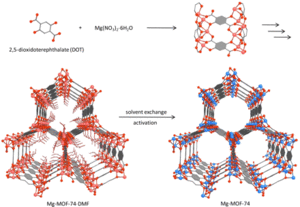Gas masksNew gas mask filtration materials show promise
Scientists are examining the possibility of metal-organic framework compounds (MOFs) — porous crystalline materials which are made up metal ions and bridged with organics — as a possible evolution in gas mask filtration technology. Thought MOFs may still be a way from real-world application, the impact that they might have on respiration technologies could be significant.

Structure of MOF used to remove cabon // Source: ac.cn
Scientists are examining the possibility of metal-organic framework compounds (MOFs) — porous crystalline materials which are made up metal ions and bridged with organics — as a possible evolution in gas mask filtration technology.
As Chemical & Engineering News reports, chemical engineers have experimented with the materials, and how they can function as filtration materials better than the standard charcoal that has previously been used.
“We have been using activated carbon to remove toxic gases for about 100 years,” said Gregory Peterson, the leader of a gas filtration research group at the Edgewood Chemical Biological Center (ECBC), on the earlier carbon-based technology.
Despite the general success of older filtration technology, carbon cannot protect soldiers from all conceivable conditions. Peterson notes that one of the many of the shortcomings of carbon-based filtration is the relatively weak physical absorption which slowly degrades the filter.
With MOF technology, however, the extremely porous materials allow for filtration via a much more extreme surface area.
“If pores are too small or blocked, toxic gas molecules cannot reach absorption sites,” said Krista Walton, a chemical engineer at the Georgia Institute of Technology. “If they are too large, there may be insufficient interaction between the pore walls and the gas molecules for optimal trapping. You need to find the sweet spot.”
A number of research groups have conducted studies and reached similar results in examining how MOFs can traps poisons such as carbon monoxide, nitrogen oxide, sulfur dioxide, and other compounds. These studies, of which Peterson recently headed an overall review, are helping to guide scientists toward which MOFs might be the most effective.
Additionally, some of these new materials can also neutralize the compound chemically, and not just by trapping it with pores. Finding the right compound to neutralize, however, is of utmost importance, or a distinctly negative reaction would result.
“With nerve agents, cleaving the right bond is critical,” said Omar Farha, a chemist at Northwestern University. “If you cleave the wrong bond, the product can be as nasty as the real thing.”
Seeing the success of some MOFs in the laboratory, however, is only half of the solution. Filtration materials must be submitted to intensive tests before they can be approved for use by the U.S. Army, Navy, Marine Corps, or Air Force.
“I’ve seen many technologies that work well in the lab but don’t survive in the harsh field environment,” said William Fritch, an ECBC product manager.
Thought MOFs may still be a way from real-world application, the impact that they might have on respiration technologies could be significant.
